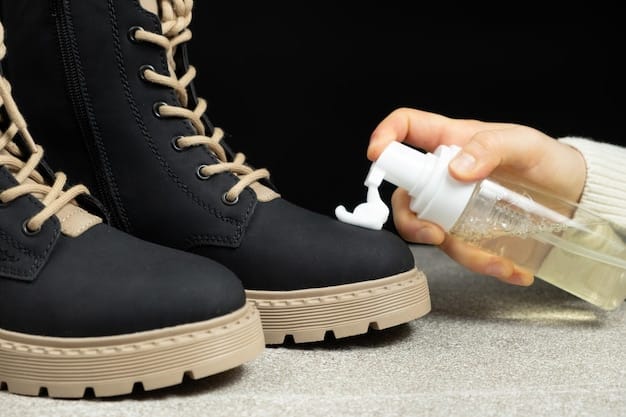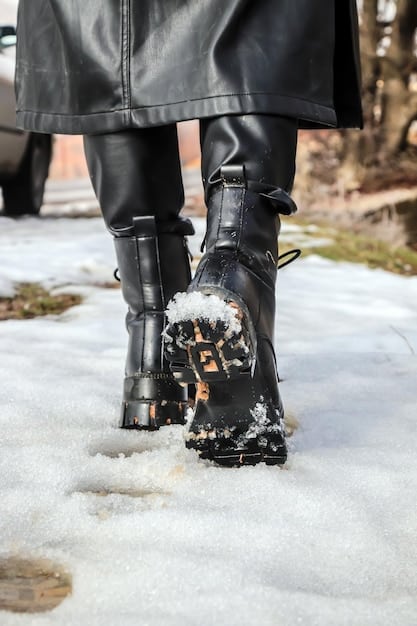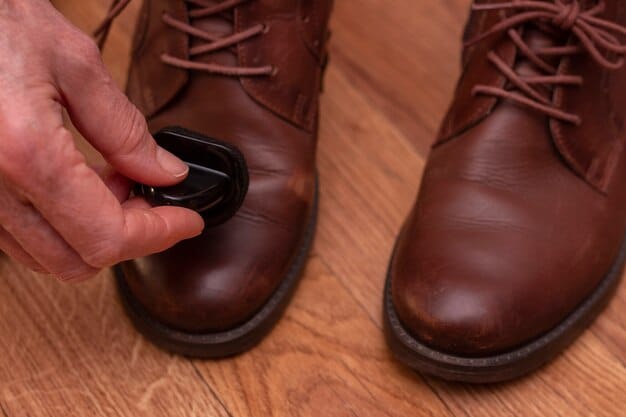The Ultimate Guide to Waterproofing Leather Boots Before German Winter

Advertisements
The ultimate guide to waterproofing your leather boots before the German winter involves cleaning, conditioning, applying waterproofing products, and regular maintenance to protect them from harsh weather conditions.
As the German winter approaches, ensuring your leather boots are waterproof is essential for comfort and longevity. This guide provides practical steps on the ultimate guide to waterproofing your leather boots before German Winter, keeping your feet dry and your boots in top condition.
Advertisements
Why Waterproofing Your Leather Boots is Crucial Before Winter
Waterproofing your leather boots before the German winter isn’t just about comfort; it’s about preserving your investment. Leather, while durable, is susceptible to water damage, salt stains, and the general wear and tear of winter conditions.
Understanding the importance of waterproofing can save you money and hassle in the long run, ensuring your boots last for many winters to come.
Advertisements
Preventing Water Damage
Water can seep into the leather, causing it to swell, stretch, and lose its shape. This not only makes the boots uncomfortable but also weakens the material, leading to cracks and tears.
- Reduces Leather Degradation: Prevents the breakdown of leather fibers.
- Maintains Boot Shape: Keeps the boots from stretching and losing form.
- Avoids Cracking: Prevents leather from cracking due to excessive moisture.
Protecting Against Salt Stains
In Germany, roads and sidewalks are often treated with salt to melt ice and snow. This salt can leave unsightly stains on your leather boots and, more importantly, dry out the leather, making it brittle.
- Blocks Salt Absorption: Creates a barrier against salt penetration.
- Maintains Appearance: Keeps boots looking clean and new.
- Extends Boot Life: Prevents premature aging and wear.

Waterproofing your leather boots is essential to protect them from water damage and salt stains, preserving their condition and extending their lifespan throughout the harsh German winter.
Essential Supplies for Waterproofing
Before you begin the waterproofing process, gather the necessary supplies to ensure optimal results. Having the right tools and products on hand will make the task easier and more effective.
Here’s a list of essential items you’ll need to properly waterproof your leather boots.
Cleaning Supplies
Begin by thoroughly cleaning your boots to remove dirt, grime, and any existing buildup. This prepares the leather for the waterproofing treatment.
- Leather Cleaner: Specifically designed for leather, it gently removes dirt without damaging the material.
- Soft Cloth or Brush: For scrubbing and wiping away dirt.
- Water: Use sparingly to dampen the cloth or brush.
Conditioning Products
Conditioning the leather is vital to keep it supple and prevent it from drying out. A good leather conditioner will nourish the material and restore its natural oils.
- Leather Conditioner: Choose a high-quality conditioner suitable for your type of leather.
- Application Cloth: A clean, soft cloth for applying the conditioner.
Waterproofing Products
The final step is to apply a waterproofing product that creates a protective barrier against water and other elements. There are several types of waterproofing products available, each with its own advantages.
The most common include:
- Wax-Based Waterproofing: Provides a durable, long-lasting barrier.
- Silicone-Based Sprays: Easy to apply and quick-drying.
- Leather Sealants: Offer a balance between protection and breathability.
Selecting the correct waterproofing product and having the right supplies will enhance the effectiveness of your waterproofing efforts, ensuring your leather boots are fully prepared for the German winter.
Step-by-Step Guide to Waterproofing Leather Boots
Now that you have all the necessary supplies, let’s move on to the actual waterproofing process. Follow these step-by-step instructions to ensure your leather boots are well-protected against the German winter elements.
Each step is crucial for achieving the best results, so take your time and pay close attention to detail.
Cleaning the Boots
Start by cleaning your leather boots to remove any dirt or debris. This allows the waterproofing product to adhere properly.
- Remove Laces: Take out the laces to ensure thorough cleaning.
- Wipe Off Excess Dirt: Use a dry cloth to wipe off any loose dirt.
- Apply Leather Cleaner: Apply a small amount of leather cleaner to a damp cloth and gently scrub the boots.
- Rinse (If Necessary): If using a cleaner that requires rinsing, do so sparingly with a damp cloth.
- Dry the Boots: Allow the boots to air dry completely before moving on to the next step.
Conditioning the Leather
Once the boots are clean and dry, it’s time to condition the leather. This helps keep the leather soft and prevents it from cracking.
- Apply Conditioner: Apply a small amount of leather conditioner to a clean cloth.
- Rub into Leather: Gently rub the conditioner into the leather, using circular motions.
- Allow Absorption: Let the conditioner absorb into the leather for at least 15-20 minutes.
- Wipe Off Excess: Wipe off any excess conditioner with a clean cloth.

Applying Waterproofing Product
After conditioning, it’s time to apply the waterproofing product. Choose the product based on your preference and the type of leather your boots are made of.
- Wax-Based Waterproofing: Apply a thin, even layer of wax with a cloth or applicator. Work the wax into the seams and creases. Use a heat gun or hairdryer on low setting to help the wax penetrate the leather.
- Silicone-Based Spray: Hold the spray can about 6-8 inches away from the boots and apply an even coat. Ensure you cover all areas, including the seams. Allow the spray to dry completely, as per the product instructions.
- Leather Sealant: Apply the sealant with a cloth or brush, ensuring even coverage. Allow it to dry completely, as per the product instructions.
By meticulously following cleaning, conditioning, and waterproofing steps, you can ensure the best possible protection for your leather boots against the harsh conditions of the German winter.
Choosing the Right Waterproofing Product
Selecting the appropriate waterproofing product is critical for ensuring your leather boots are adequately protected. Different products offer varying levels of protection and are suited for different types of leather.
Understanding the characteristics of each type will help you make an informed decision.
Wax-Based Waterproofing
Wax-based products are known for their durability and long-lasting protection. They create a solid barrier that effectively repels water and provides excellent resistance against harsh winter conditions. However, they can sometimes alter the leather’s appearance and breathability.
- Pros: Excellent water resistance, long-lasting, ideal for heavy-duty use.
- Cons: Can darken leather, may reduce breathability.
- Best For: Boots used in harsh conditions, such as hiking or heavy snow.
Silicone-Based Sprays
Silicone-based sprays are easy to apply and quick-drying, making them a convenient option for regular maintenance. They provide good water resistance and are suitable for a variety of leather types. However, they may not be as durable as wax-based products and may require more frequent application.
- Pros: Easy to apply, quick-drying, suitable for various leather types.
- Cons: May require more frequent application, less durable than wax.
- Best For: Casual boots, boots requiring frequent maintenance.
Leather Sealants
Leather sealants offer a balance between protection and breathability. They create a protective layer that repels water while allowing the leather to breathe, preventing moisture buildup inside the boot. This makes them a good choice for boots worn in moderate winter conditions.
- Pros: Good balance of protection and breathability, suitable for moderate conditions.
- Cons: May not be as durable as wax-based products in extreme conditions.
- Best For: Boots worn in moderate winter conditions, everyday use.
Carefully considering the advantages and disadvantages of wax-based waterproofing, silicone-based sprays, and leather sealants will enable you to select the best option for your needs, ensuring your leather boots are well-prepared for the German winter.
Maintaining Waterproofing Throughout Winter
Once you’ve waterproofed your leather boots, ongoing maintenance is key to preserving their protection throughout the winter months. Regular care will ensure your boots remain in excellent condition and continue to repel water effectively.
Here are some essential maintenance tips to keep in mind.
Regular Cleaning
Cleaning your boots regularly will prevent the buildup of dirt, salt, and other debris that can compromise the waterproofing treatment. Use a soft cloth or brush to wipe off any dirt after each use.
- After Each Use: Wipe off dirt and salt with a damp cloth.
- Weekly Deep Clean: Use a leather cleaner for a more thorough cleaning.
Reapplication of Waterproofing
Depending on the product you use and the frequency of wear, you may need to reapply the waterproofing treatment periodically. Check the product instructions for recommended reapplication intervals.
- Check Product Instructions: Follow the manufacturer’s guidelines for reapplication.
- Noticeable Wear: Reapply when you notice water soaking into the leather.
Proper Storage
How you store your boots can also affect their longevity. Store them in a cool, dry place away from direct sunlight and heat. Use boot trees to help maintain their shape.
- Cool, Dry Place: Avoid damp or humid environments.
- Boot Trees: Help maintain the shape and prevent creases.
| Key Point | Brief Description |
|---|---|
| 💧 Cleaning Boots | Removes dirt for better waterproofing adhesion. |
| 🛡️ Conditioning Leather | Keeps leather supple and prevents cracking. |
| ❄️ Applying Protection | Wax, sprays, or sealants to repel water. |
| 🔄 Regular Care | Maintain waterproofing with cleaning and reapplication. |
Frequently Asked Questions
▼
Clean your leather boots after each use to remove dirt and salt, and perform a deeper clean with a leather cleaner weekly.
▼
No, choose a spray specifically designed for leather to avoid damage. Always test a small area first.
▼
Reapply when you notice water soaking into the leather instead of beading up and rolling off the surface.
▼
Yes, conditioning keeps the leather supple and prevents it from cracking, extending the life of your boots.
▼
Avoid direct heat as it can dry out the leather. Air dry them in a cool, dry place, using boot trees to maintain shape.
Conclusion
Waterproofing your leather boots before the German winter is a proactive step that ensures their longevity and your comfort. By following this comprehensive guide, you can confidently protect your boots from water damage, salt stains, and the general wear and tear of winter, allowing you to step out in style and comfort, no matter the weather.